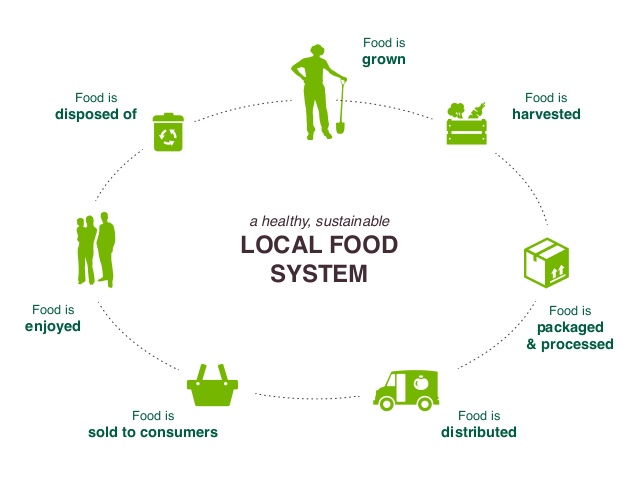What is a foodshed?
A foodshed is defined as a geographical region in which food grown locally is available to feed the local population. Like water in a watershed drains from nearby peaks to feed a central body of water, food within a foodshed moves from the soil, through the hands of a local farmer, and is transported and consumed all within the same region. In a very healthy, sustainable foodshed, all of the stages of the food system including; food production, transportation, consumption, and waste management, all stays within that particular vicinity and exists as a cycle. The aim for every foodshed is to create a healthy, vibrant, sustainable food system within their community. Within our West Central Mountains foodshed, we have farmers markets, a food coalition, community gardens, small farms, food pantries, apiaries, cheese-makers, commercial kitchens, CSA’s, ranches, poultry farms, locally produced beverages and many more ways in which to eat/drink locally. We are all a part of a foodshed, yet some have more/less food available than others and have differing challenges to their food system due to many factors.

Characteristics and Challenges to our Foodshed
The West Central Mountain foodshed stretches from New Meadows in the north to Cascade in the south and fits between the Salmon River mountain range to the east and the West Mountain range due west. This foodshed is considered high-altitude, with an average elevation of around 5,000 feet. High-altitudes generally contribute to a colder, shorter growing season, and thus, our region only has around 60 frost-free days in which to grow food, with a hardiness zone 5a. The varieties and types of food we are able to grow/farm/ranch are curtailed by these shorter, colder seasons, and thus, high tunnels, greenhouses and cold-frames are sometimes utilized to extend the life of the plants. The University of Idaho has many publications on how to grow food within high-altitude, short-season zones because it can be difficult. Certain challenges to farming in our region lead us to going outside of our foodshed in order to purchase a more diverse variety of foods and local products.

The term “local food” can be a hard radius to pin down. A good goal is to purchase foods and products as close to home as you can, which cuts down on emissions due to a short transportation process, and supports your local economy (your neighbors!). Just outside the West Central Mountains foodshed region, yet still close to home, we can find longer, hotter growing seasons at lower elevations, such as Riggins and Council, in which we can purchase more diverse local food. Buying food closer to home is important, whether that is within the state of Idaho, or choosing to buy apples from Washington versus New Zealand, as transportation adds to carbon emissions. The more you can buy locally, the more your local food system will thrive and be sustainable into the future. There is a grass-roots group of folks interested in local foods under the West Central Mountains Food Coalition which can be a great place to connect with other locavores and to check out more about our food system and how to support it as it continues to grow.
Continuing the conversation
I hope this post gives some framework for foodsheds, food systems and some of the factors affecting those structures. Feeding Our Adventures will continue to delve deeper into the intricacies of our foodshed and food system throughout this journey. From stories of local purveyors, to recipes, compost-how-to’s, foraging, farming, food education, even art and creative writing...we will continue to explore our foodshed together!
